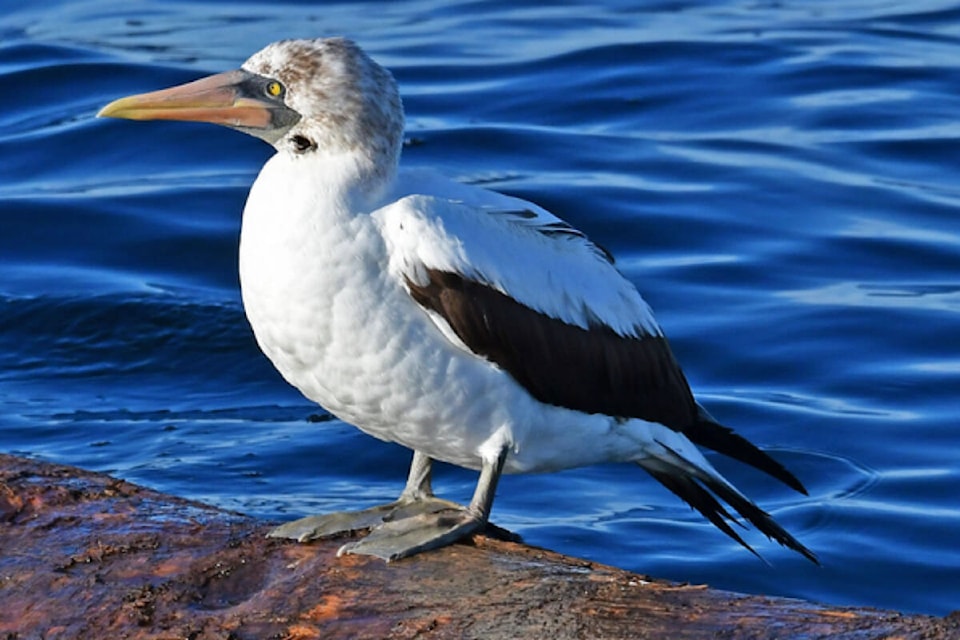Tasli Shaw took her whale-watching zodiac on a wild ride July 23 when a lone Nazca booby, a bird native to Latin America only recorded twice before in B.C., graced the waters off Victoria right before her eyes.
Shaw, who captains a 24-foot boat for Ocean EcoVentures in Cowichan Bay, had already enjoyed a full day at sea with two wildlife-watching highlights: a mother humpback whale playing with its calf and a harbour seal giving birth.
“The seas were rough and I decided it was time to get back to calmer waters.”
Starting to head for home port around 5 p.m., she caught sight of a big white bird off the Trial Islands with a flight pattern unlike any gull she’d ever observed. Shaw couldn’t tell the exact species, but knew from her inner birder and the way it flapped and circled about that it was some kind of booby – all of which are rare in Greater Victoria – and she needed to record it.
ALSO READ: Salvation Army collecting school supplies for West Shore families
She described the subsequent challenge of trying to simultaneously track and film the bird, navigate the boat and keep her passengers as dry as possible, saying it was a pretty high-stakes moment for herself and those along for the ride.
“I think they were initially kind of confused why I was basically doing a doughnut trying to follow this bird.”
They came to appreciate her efforts once she explained they may have just joined the lucky few in the province to witness this species. She later went to BC Rare Bird Alert to notify the larger birder network of this unidentified sighting.
“It would probably be the highlight of my career, if I imagine,” she said, adding that “the booby still took the cake” against the playful humpbacks and birthing seal. This “truly organic experience” also topped her previous sighting of a brown booby, which she explained was merely spoon-fed to her by others who’d already seen it.
Local biologist Jacques Sirois said it’s the first recorded sighting of the Nazca booby, which breeds as far south as Peru and the Galapagos Islands, in the Victoria Harbour Migratory Bird Sanctuary. Of the three sightings of this species so far in B.C., it’s only the second to be seen alive.
According to birder Geoffrey Newell, that same booby passed through Puget Sound near Seattle days earlier and made further appearances at the Race Rocks and Trial Islands ecological reserves for subsequent whale watchers to enjoy. “It’s irritating because no birders got to see it,” he said.
If he’d had the chance to set his binoculars on it, Newell added, his heart would’ve begun to beat extremely fast and he’d be jumping up to touch the clouds. “It’s a super rare bird anywhere in Canada.”
The Nazca booby typically breeds no further north than southern California or Mexico, he said. “It probably turned up because of that streak of hot weather we had.”
ALSO READ: District of Saanich launches online permit and development tracker dashboard
Rare enough as this sighting already is, climate change means we likely won’t see a Nazca booby again in Greater Victoria. During this one’s multi-day visit, Newell noted it didn’t even land onshore in areas where no other birds were nesting.
The term ‘booby’ comes from the Spanish slang term ‘bobo,’ meaning stupid, which references how these seabirds fearlessly landed on ships in the 18th century and made themselves easy targets for sailors. Implicit stupidity aside, Newell called the Nazca booby a highly comical bird due to the combination of its mostly white colour, size of a cormorant and similar bill shape to a pelican. Perhaps its most unique feature is what he called its “sponge dive.”
“Once it’s got its sights locked on something, it’ll tuck its wings in and dive in the water, hardly making a sound.”
He said it also carries itself with a “very obvious” flight pattern one can distinguish even from a distance, as was the case for Shaw. She acknowledged Greater Victoria is an unusual and likely challenging area for a Nazca booby to live in.
“I hope it’s able to either go back (south) or somehow manage to thrive (here).”
Do you have a story tip? Email: evert.lindquist@blackpress.ca.
Follow us on Twitter and Instagram, and like us on Facebook.
